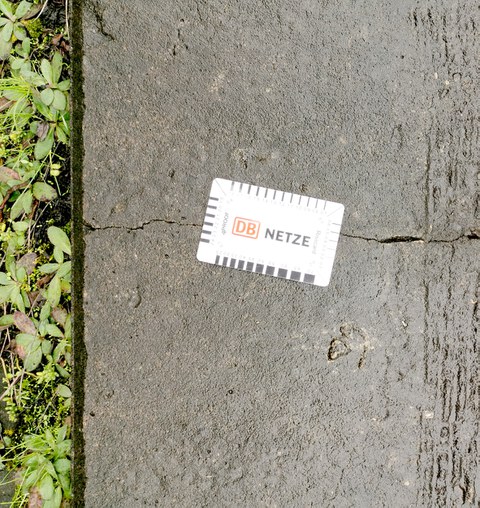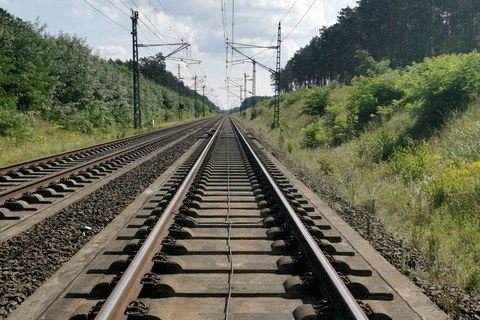Expert assessment of the ballastless track
Table of contents
Project data
| Titel | Title Gutachterliche Bewertung der Festen Fahrbahn | Expert assessment of the ballastless track Auftraggeber | Client |
Report from annual report 2023
Detection of damages to ballastless tracks

Capturing of cracks on the top of a concrete base layer
In the course of developing high-speed corridors within the German railway network, the application of the ballastless tracks is a common practice. It is attributed with a longer service life, reduced maintenance costs, and enhanced ride comfort. However, certain routes in the German network exhibit high maintenance costs, a partially inferior track position compared to the conventional ballast track, and a jeopardized service life of 60 years.
In this context, a comprehensive expert evaluation of the Berlin–Oebisfelde route is being pursued. The overarching goal of this project is to develop a forward-looking ballastless track system that can achieve a service life of 60 years. To realize this objective, existing data must be researched, damages to ballastless tracks inspected, existing constructions evaluated, and a continuous maintenance strategy devised.
To procure the necessary existing data, numerous archives have been visited, and pertinent information has been synthesized. These existing data serve as the foundation for the subsequent analysis of damages throughout the project.
Another significant aspect of the project is the detailed recording of damages to ballastless tracks. Numerous track inspections have been conducted, participating in regularly scheduled inspection walks in the DB regions. A comprehensive damage catalog has been created from on-site recordings, meticulously listing all damages and deficiencies per construction type. This catalog encompasses all relevant aspects such as various crack formations, chippings, track instabilities, visual imperfections, and other noteworthy peculiarities.
Based on this comprehensive damage data, not only damage categorization and evaluation can be performed, but it also opens up to develop a maintenance strategy for the upcoming years. Furthermore, these insights enable the derivation of optimizations to be incorporated into the development of future ballastless track systems.
Summary

Ballastless track
In the context of the creation of high-speed corridors in the German rail network, slab track construction is frequently used. The construction is said to have a longer service life, lower maintenance costs and greater travel comfort. This is associated with higher costs in new construction. The development of slab track is now over 50 years old and various systems have become established. New construction has progressed strongly over the last 25 years, so that a network of over 1,400 km of ballastless track has now been built in Germany. Some of the construction types are already over 50 years old and will soon reach a final age of 60 years. The task of maintenance must be ensured over this period and an evaluation made of possible replacement construction.
The project aim is to analyze, improve, and optimize the maintenance measures for the different slab track construction systems. The challenges and requirements of the slab track will be intensively addressed and innovative solutions will be developed to ensure its longevity and performance. During the course of the project, various aspects of the slab track will be investigated. These include monitoring and inspecting its condition, evaluating its load-bearing capacity, and developing repair strategies. A major concern of the project is to explore and apply innovative technologies and methods to increase the efficiency and effectiveness of slab track maintenance. This may include the use of advanced monitoring systems, data-driven analysis techniques, and automated inspection tools.
